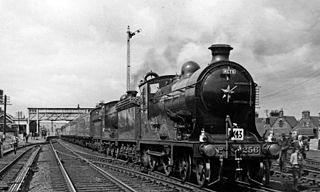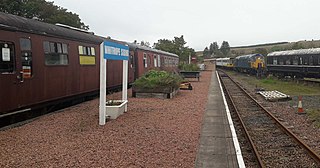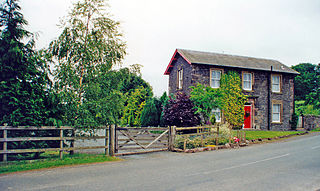
St Enoch station was a mainline railway station in the city of Glasgow, Scotland between 1876 and 1966. The hotel was the first building in Glasgow to be fitted out with electric lighting. The station was demolished in 1977.

The Waverley Route was a railway line that ran south from Edinburgh, through Midlothian and the Scottish Borders, to Carlisle. The line was built by the North British Railway; the stretch from Edinburgh to Hawick opened in 1849 and the remainder to Carlisle opened in 1862. The line was nicknamed after the immensely popular Waverley Novels, written by Sir Walter Scott.

Whitrope Siding was a trailing short siding or spur off the "up" (southbound) line, an associated trailing cross-over between up and down lines, a pair of railway cottages and a signal box on the Waverley Line or Waverley Route. It was used as a goods loading bay. The site is now the home of the Whitrope Heritage Centre, as well as the current terminus of the heritage Border Union Railway.

Whitrope is a densely forested, but sparsely populated area, high in the Southern Upland hills in the south central Scottish Borders in the former county of Roxburghshire. Situated some 12 miles south from Hawick on the B6399 road, the Scottish watershed passes through the area; Whitrope Burn draining south towards Newcastleton and Flosh Burn draining north towards Hawick.
The Glasgow and Paisley Joint Railway was the section of railway line between Glasgow Bridge Street railway station and Paisley, in the west of Scotland. It was constructed and operated jointly by two competing railway companies as the stem of their lines to Greenock and Ayr respectively, and it opened in 1840. The Joint Committee, which controlled the line, built a branch to Govan and later to Cessnock Dock, and then Prince's Dock.

Bridge Street railway station, now disused, was the original Glasgow terminus of the Glasgow and Paisley Joint Railway; jointly owned by the Glasgow, Paisley and Greenock Railway (GP&G), which later merged with the Caledonian Railway, and the Glasgow, Paisley, Kilmarnock and Ayr Railway (GPK&A), which became part of the Glasgow & South Western Railway.

Waverley Route Heritage Association is a heritage railway group involved with the history, heritage and preservation of the Waverley Route, based/centred on Whitrope, south of Hawick, Scotland.

Lyoncross railway station was intended to be a railway station between the towns of Newton Mearns and Barrhead, Scotland as part of the Lanarkshire and Ayrshire Railway.

Gorebridge is a railway station on the Borders Railway, which runs between Edinburgh Waverley and Tweedbank. The station, situated 11 miles 77 chains (19 km) south-east of Edinburgh Waverley, serves the town of Gorebridge in Midlothian, Scotland. It is owned by Network Rail and managed by Abellio ScotRail.
The Caledonian Railway main line in Scotland connected Glasgow and Edinburgh with Carlisle, via Carstairs and Beattock.

Redesmouth is a village in Northumberland, England, just over 1 mile (1.6 km) to the south-east of Bellingham.
The Border Counties Railway was a railway line connecting Hexham in Northumberland, with Riccarton Junction on the Waverley Route in Roxburghshire.
The Glasgow and Milngavie Junction Railway was a short locally promoted branch line built to connect the industrial town of Milngavie with the main line railway network, near Glasgow, Scotland. It opened in 1863.
The Hamilton and Strathaven Railway was a historic railway in Scotland. It ran from a junction with the Hamilton Branch of the Caledonian Railway to a terminus at Strathaven. The railway was worked from the start by the Caledonian Railway, who absorbed the railway company in 1864.
The Border Union Railway was a railway line which connected places in the south of Scotland and Cumberland in England. It was authorised on 21 July 1859 and advertised as the Waverley Route by the promoters - the North British Railway. It connected the Edinburgh and Hawick Railway at Hawick with Carlisle.

Falstone railway station is a former railway station that served the hamlet of Falstone, in Northumberland, England.
Kielder railway station is a closed railway station that served the village hamlet of Kielder, Northumberland.

Deadwater railway station is a closed railway station situated on the border between England and Scotland at the head of the North Tyne River. The station served the settlement of Deadwater which consisted of just six houses.

Saughtree railway station is a closed railway station situated a mile north of the hamlet of Saughtree and two miles from the border with England.

Fountainhall railway station served the village of Fountainhall, Scottish Borders from 1848 to 1969 on the Waverley Route.













